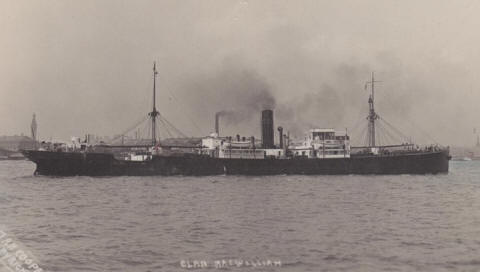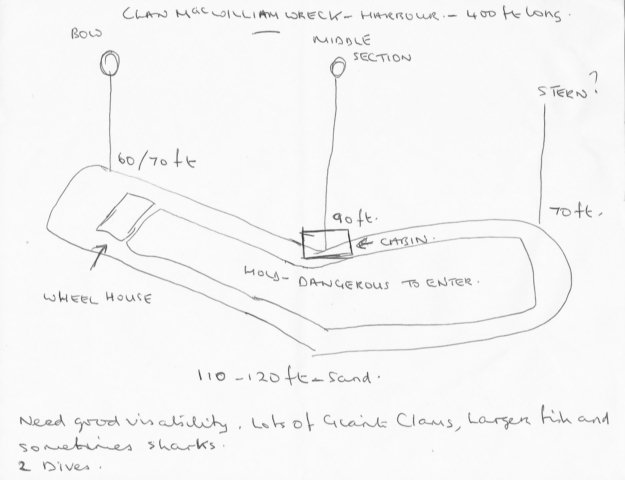 Location
LocationDiving the Clan MacWilliam Wreck
Vava'u Tonga
In Neiafu Harbor - 18-40.348 S / 173-59.351 W
Accessible by dinghy from any anchorage in the harbor.
General Info
The Clan McWilliam lies in 122' (37m) of water at the far end of Neiafu harbor. She was a 6,000-ton, 423' (127m) copra steamer, built in 1918. In December 1927, she steamed into Neiafu harbor with a smoldering fire in her #3 hold. The forward holds collapsed, cracking open several plates. The captain and engineer tried to save the ship by running it aground in the shallows at the foot of the bay but didn't make it in time. One story has it that the captain locked the engineer into the engine room to keep him from abandoning the effort. (See the official version below from the inquiry conducted in Nuku'alofa immediately after the incident)
The wreck superstructure starts at about 60 feet, and the bottom is at 120 feet. Most of the deck is between 80-95' deep, so your bottom time will be limited to only about 20 minutes. If you are going to explore the whole wreck thoroughly, plan to do it in 2 dives, turning around at the main cabin (approx in the middle of the wreck).
Good visibility is essential for this dive. This wreck is old, and it is dangerous to attempt any penetration of the wreck.
The sketch shows 3 buoys marking the wreck (bow, middle, and stern). The bow buoy is to the east. The middle buoy is missing (as of early 2012). The stern buoy now trails off the wreck horizontally for about 100 feet, at 15-25' depth (a good place to do your safety stop). On a day with decent visibility, you can just start to see the wreck below you at about 30'.
Dive Profile

Dive Profile & Sketch courtesy of
Two If By Sea Sail & Dive Charters
More Clan MacWilliam Info
Excerpt from the Official Inquiry about the Sinking:
From Fiji she proceeded to Nukualofa, Tonga, for copra, and thence to Vavau, the main northerly island of the Friendly Islands. She anchored in Neiafu Harbour, Vavau, at 7.27 a.m. on the 23rd December, 1927, and commenced loading copra. She loaded into holds Nos. 1 and 2. Loading continued throughout the day. Loading in No. 2 was completed at 1.30 a.m. on the 24th December, 1927, and the labour gang, which consisted of Pacific Islanders, was transferred to No. 1. About 1.55 a.m. on the same morning, the hatchman, Aleck Williams, a half caste Samoan, went down into No. 2 to see if any of the labour was still in the hold. He observed that fire had broken out. He states in his evidence that he saw one end of a wire sparking, and that he then saw a flame in the copra dust. He raised the alarm, and Joseph Hall Mellor, Second Mate, who was on watch, gave orders for hoses to be connected up and all hands to be called. The Second Mate went into the hold with fire extinguishers, which he fired without effect. At this time Apprentice Freestone, Mr. Johnson and Jeremiah Bryce were in the hold endeavouring to fight the fire, but to no effect. Shortly after 2 a.m. three hoses were playing on the fire, which by this time, according to the evidence of the Mate, looked like a blazing furnace, spreading all the time. At 3.30 a.m. No. 1 was ablaze. It contained copra. At 4.30 a.m. the fire was gaining ground, and the steamer was shifted to the head of the harbour, where she anchored in 20 fathoms-latitude 18° 40' 15" S., longitude 173° 59' 27" W. Flooding was ordered by the Master at 6.50 a.m., and shortly afterwards two life boats were lowered. At 9 a.m. the foremast sank, and shortly after the starboard side fell in. Throughout the day the fire increased in force, and at 4 o'clock a.m. on the 25th the port side fell in. At 6.45 a.m. No. 3 hatch burst into flames, and at 8.30 a.m. the stokehold bulkhead was red hot. At 8.45 a.m. the ship buckled, and the Master gave orders to abandon ship. At 9 a.m. the ship broke, plunged and sank rapidly.
The Court further finds that when the steamer dived before sinking, the Master, William Thomson, was on the ladder on his way to the boat, and that he went down with the ship and was drowned. At this time the Chief Engineer, John G. Dishington, was in, or near to, his cabin, and the Court finds that he sank with the ship and was drowned. Throughout the fire these two officers directed operations in a calm and collected manner, and the Court, in placing on record its high opinion of their conduct, extends its sympathy to the relatives bereaved.